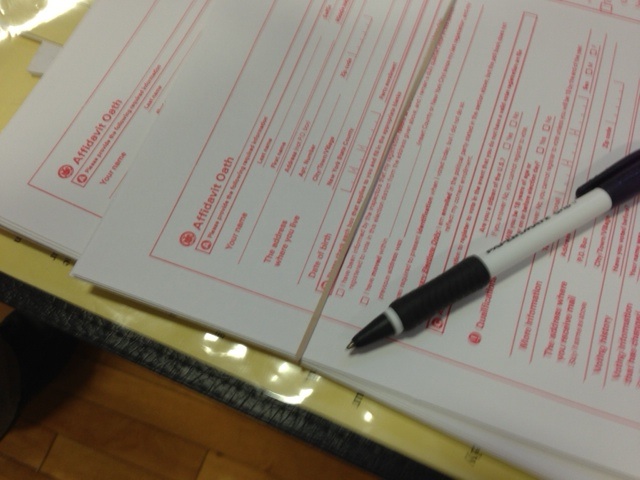“It became, like, a desperate attempt: ‘I just want something like this.’ And she did this outline of a strawberry and a dove or something. I said, ‘That’s what you want?’ And she said, ‘Yeah, if you could do this exact thing.’ My patience was thin at that point. So I wound up doing an outline of her own drawing on her ankle.”
Rubendall laughs again. Same laugh.
“Would I have been more successful in the city? I think I would tattoo more celebrities in the city. Which is not always a good thing.”
Rubendall tells another story, from back in the Da Vinci days. A guy walks into the store and asks Rubendall to ink a couple of praying mantises, fighting, on his stomach. OK. Fair enough. Then the guy tells Rubendall, “I’m thinking of getting some writing, too.” OK, says Rubendall, what do you want written? Underneath two praying mantises that are fighting, the guy asks Rubendall to write: Two praying mantises, fighting.
Rubendall laughs again. It’s laughter born of incredulity, experience and acceptance, laughter that recognizes a good story, loves to hear a good story, tell a good story. He’s got a million of ’em.
“You run into characters like that on a daily basis,” says Rubendall. “I’ve seen the best of the best and the worst of the worst. That’s another thing I love about tattooing: Every day is different. You don’t know what’s in store.”
*******************************
Rubendall’s first tattoo was given to him on his 18th birthday by Romano: the word “Mother,” on the inside of his lip.
“I had to strategically place it,” says Rubendall, “so it wouldn’t interfere with future plans.”
Those future plans were a body suit, which he has spent the years since collecting. The first piece of the suit was done by a Farmingdale native named Mike Ledger, who was working out of Hempstead at the time. (Ledger now works out of Honolulu, and is himself a household name in tattooing.) For the next piece, though, Rubendall had to travel—he wanted to get tattooed by the legendary European artist Filip Leu. So, after a lengthy mail correspondence (this was a time before e-mail, and the gypsy-like Leu had no phone), the 19-year-old Rubendall set up an appointment to fly to Switzerland and have his arms done by Leu.
“My mother thought I was completely crazy,” Rubendall laughs. He saved every penny he made tattooing to pay for the airfare, the lodging and Leu’s fees. Eventually, he notes, his mom came around. “I wound up going with her. She came with me with my sister. We made a family trip out of it.”
Back then, remembers Rubendall, such excursions were almost unheard of.
“People around me, they never traveled to get tattoos,” he says. “They would stay on Long Island, and if they had to drive, that was good enough. But I always thought, it’s such a permanent thing, it’s there forever, why wouldn’t you go wherever, to any lengths?”
Rubendall had Leu tattoo his arms so the young upstart could watch the legend at work, study his technique, learn his tricks, his secrets. “It opens your eyes to what can be done,” says Rubendall. “It’s more than just technique. For me it raised the bar. It set my standards really high, to see how good people could be at tattooing.” Rubendall calls this a pivotal moment in his career. He has since traveled to Texas, to be tattooed by Chris Trevino (another influential tattooer from the same school as Rubendall and O’Donnell), and he is currently in the process of being tattooed by Japanese artist Horitomo, who is working out of San Jose, California. Horitomo is completing Rubendall’s body suit—doing his front and legs. Unlike American tattooers, however, Horitomo practices tebori, the traditional Japanese style of tattooing, wherein the work is done not by machine, but by hand, using thick needles attached to a bamboo rod. It takes much longer than tattooing by machine, it looks much different—simpler, with different colors and hues—and by most accounts, it is also much more painful.
“It’s pretty barbaric,” says Rubendall. “It seems like a very primitive technique, but it definitely gets the job done.”
The piece being done by Horitomo is enormous and incredibly beautiful, and it has a deep personal meaning to Rubendall: It is an image of Kishibojin, the Japanese goddess of fertility and protection of children. Rubendall chose to recreate that story on his body because he has his own family now to protect: a wife and two young daughters—his oldest is 2 years old, his youngest is 2 months. Kishibojin is his tribute to them.
Today, tattooing has taken Rubendall around the world, both as a collector and as an artist: He has been to Italy, Denmark, Japan, Sweden, Spain… He comes back, always, to Massapequa. Where it all began.
“I’m comfortable with it now,” he says, quietly. “I feel like I’m in a good place.”








